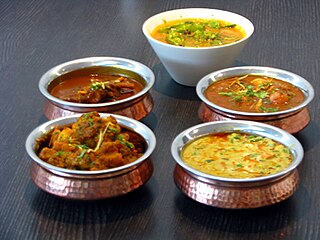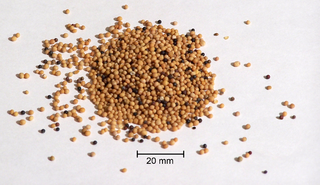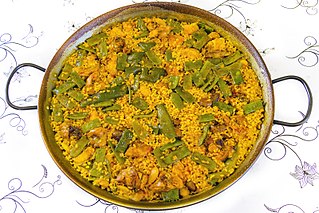
Paella is a Valencian rice dish that has ancient roots but its modern form originated in the mid-19th century in the area around Albufera lagoon on the east coast of Spain adjacent to the city of Valencia. Many non-Spaniards view paella as Spain's national dish, but most Spaniards consider it to be a regional Valencian dish. Valencians, in turn, regard paella as one of their identifying symbols.

Meze or mezze is a selection of small dishes served as appetizers in parts of the Middle East, the Balkans, Greece, and North Africa. In the Muslim regions where it is present, meze is often served as a part of multi-course meals, while in Greece and the Balkans they function more as snacks while drinking or talking.
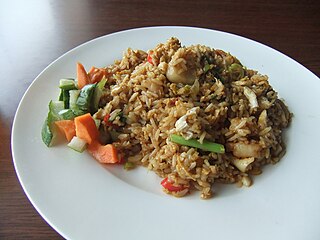
Fried rice is a dish of cooked rice that has been stir-fried in a wok or a frying pan and is usually mixed with other ingredients such as eggs, vegetables, seafood, or meat. It is often eaten by itself or as an accompaniment to another dish. Fried rice is a popular component of East Asian, Southeast Asian and certain South Asian cuisines. As a homemade dish, fried rice is typically made with ingredients left over from other dishes, leading to countless variations. Being an economical hodgepodge, the same approach is often taken with fried noodles or pyttipanna as well. Fried rice first developed during the Sui Dynasty in China and as such all fried rice dishes can trace their origins to Chinese fried rice.

Sambar, also spelled sambaar is a lentil-based vegetable stew or chowder, cooked with tamarind broth, originating from South India. It is popular in South Indian and Sri Lankan cuisines.
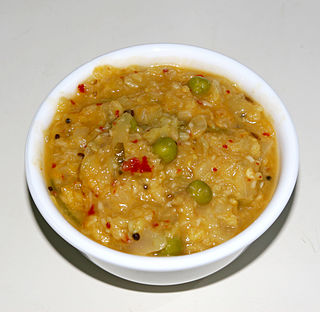
Kootu (Tamil:கூட்டு) is a Tamil word means "add" i.e. vegetable added with lentils which form the dish, made of vegetable and lentils and are semi-solid in consistency, i.e., less aqueous than sambhar, but more so than dry curries. Virundhu Sappadu comes with the combo of boiled rice, sambar, rasam, curd, poriyal, kootu, appalam, pickle and banana. All kootus by default have some vegetables and lentils, but many variations of kootu exist:

Assamese cuisine is the cuisine of Assam. It is a style of cooking that is a confluence of cooking habits of the hills that favor fermentation and drying as forms of preservation and those from the plains that provide fresh vegetables and an abundance of fish and meat. Both are centered on the main ingredient — rice. The confluence of varied cultural influences in the Assam Valley has led to the staggering variety and flavours in the Assamese food. It is characterised by the use of an extremely wide variety of plant as well as animal products, owing to their abundance in the region. It is a mixture of indigenous styles with considerable regional variations and some external influences.

Tamil cuisine is a cuisine native to the Tamil people who are native to the Indian state of Tamil Nadu and northern Sri Lanka. It is also the cuisine of the Tamil-speaking population of Karnataka, Kerala and Andhra Pradesh in India and of the Tamil communities of Singapore, Malaysia, and Indonesia.

Iraqi cuisine or Mesopotamian cuisine has a long history going back some 10,000 years – to the Sumerians, Akkadians, Babylonians, Assyrians, and ancient Persians. Tablets found in ancient ruins in Iraq show recipes prepared in the temples during religious festivals – the first cookbooks in the world. Ancient Iraq, or Mesopotamia, was home to a sophisticated and highly advanced civilization, in all fields of knowledge, including the culinary arts. However, it was in the Islamic Golden Age when Baghdad was the capital of the Abbasid Caliphate (750–1258) that the Iraqi kitchen reached its zenith. Today, the cuisine of Iraq reflects this rich inheritance as well as strong influences from the culinary traditions of neighbouring Iran, Turkey and the Syria region area.

Cypriot cuisine is the cuisine of Cyprus and is closely related to Greek and Turkish cuisine; it has also been influenced by Byzantine, French, Italian, Catalan, Ottoman and Middle Eastern cuisines.

Levantine cuisine is the traditional cuisine of the Levant, known in Arabic as the Bilad al-Sham and Mashriq, which covers a large area of the Eastern Mediterranean. It continues to carry an influentially mainstream character in a majority of the dishes today. It is found in the modern states of Jordan, Lebanon, Israel, Palestine, Syria, and parts of southern Turkey near Adana, Gaziantep, and Antakya. In the broader family of Mediterranean cuisine, Cypriot cuisine also has strong Levantine influences. Conversely, some of the dishes listed below may have early origins in neighboring regions, but have long since become traditions in the Levant.

The cuisine of Karnataka includes many vegetarian and non-vegetarian cuisines. It is one of the oldest surviving cuisines and traces its origin to the Iron Age. Ragi is mentioned in the historical works of the great poet Adikavi Pampa and in the ancient Sanskrit medical text Sushruta Samhita. The varieties of the Karnataka cuisine have drawn influence from and influenced the cuisines of neighbouring states like Tamil Nadu, Andhra Pradesh and Kerala. Although the ingredients differ from one region to another, a typical Kannadiga Oota includes the following dishes in the order specified and is served on a banana leaf: Uppu (salt), Kosambari, Pickle, Palya, Gojju, Raita, Payasa (Kheer), Thovve, Chitranna, Anna (rice), and Tuppa (ghee).

Gujarati cuisine is that of the state of Gujarat, in western India. Despite having an extensive coastline providing wholesome seafood, Gujarat is primarily a vegetarian state due to the influence of Jain vegetarianism. Many communities, however, do include seafood, chicken, and mutton in their diet.
Pachadi refers to a traditional South Indian fresh pickle served as a side dish. Broadly translated, it refers to food which has been pounded. In Karnataka, Kerala and Tamil Nadu, pachadi is a side dish curry similar to the North Indian raita, and is made with vegetable, yoghurt, coconut, ginger and curry leaves and seasoned with mustard. Pachadi generally is a mildly spiced coconut and yogurt-based dish made with seasonal vegetables or fruits.

Bhojpuri cuisine is a part of North Indian and Nepalese cuisine and a style of food preparation common amongst the Bhojpuri people living in the Bhojpuri region of Bihar and Uttar Pradesh. Bhojpuri foods are mostly mild and are less hot in term of spices used, but could be hotter and spicier according to individual preference. The food is tailor-made for Bhojpuri lifestyle in which the rural folk burn up a lot of calories in the fields. Bhojpuri people take pride in celebrating various festivals and religious rites with food; as a result, their food resembles the delicacies offered to deities.

Afghan cuisine is largely based upon the nation's chief crops, such as wheat, maize, barley and rice. Accompanying these staples are native fruits and vegetables as well as dairy products such as milk, yogurt Doogh and whey. Kabuli palaw is the national dish of Afghanistan. The nation's culinary specialties reflect its ethnic and geographic diversity. Afghanistan is known for its high quality pomegranates, grapes, and sweet, Rugby-football shaped melons.

Nigerian cuisine consists of dishes or food items from the hundreds of ethnic groups that comprise Nigeria. Like other West African cuisines, it uses spices and herbs with palm or groundnut oil to create deeply flavored sauces and soups. Nigerian feasts are colourful and lavish, while aromatic market and roadside snacks cooked on barbecues or fried in oil are plentiful and varied.

Telugu cuisine is a cuisine of South India native to the Telugu people from the states of Andhra Pradesh and Telangana. Generally known for its tangy, hot and spicy taste, the cooking is very diverse due to the vast spread of the people and varied topological regions.

Gado-gado, also known as Lotek, is an Indonesian salad of slightly boiled, blanched or steamed vegetables and hard-boiled eggs, boiled potato, fried tofu and tempeh, and lontong, served with a peanut sauce dressing. In 2018, gado-gado is promoted as one of 5 national dishes of Indonesia.
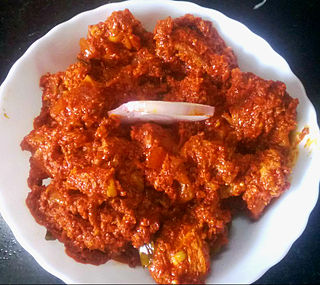
Mangalorean Chicken Sukka or Kori Sukka/Kori Ajadina(Tulu) is an Indian Dish of Chicken native to Mangalore and Udupi region. "Kori Sukka" literally means "Chicken Semi-Dry gravy" in Tulu, sometimes also called as "Kori Ajadina". However it can be prepared in two variations Dry and semi gravy.
